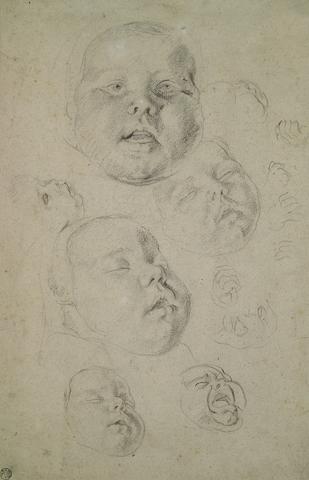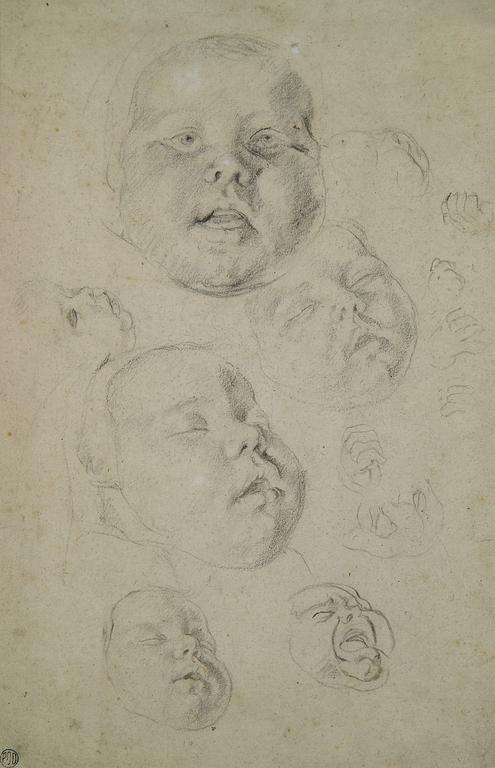
Feuille d’études (tête et mains d’un nourrisson)
Cornelis de Vos (1584 Hulst - 1651 Anvers)
1627
Crayon noir et rehauts de blanc sur papier ; inscription « A van Dyck » sur le montage d'origine ; 28,5 x 18,5 cm
Provenance :
Charles Martine ; Pierre-Olivier Dubaut (marque de collection en bas à gauche) et par descendance ; Paris, Artcurial, 30 mars 2011 ; Paris, collection Le Polyptyque ; Francfort, Städel Museum.
Exposition :
Van Dyck (Anvers, Musée des Beaux-Arts, 1949) ; Le siècle de Rubens (Bruxelles, Musée des Beaux-Arts, 1965) ; Dessins des Écoles du Nord dans les collections privées françaises (Paris, galerie Claude Aubry, 1974).
Bibliographie :
Katlijne Van der Stighelen, « Cornelis de Vos as a draughtsman », Master Drawings, vol. XXVII, n° 4, 1989.
Cornelis de Vos est avec Rubens, van Dyck et Jordaens, le « quatrième mousquetaire » de la peinture anversoise du début du 17ème siècle. Comme van Dyck, il excelle dans le portrait, moins exubérant, d’un milieu bourgeois plutôt qu’aristocratique. Et particulièrement le portrait d’enfant, seul ou dans le cercle familial, à une époque où la famille étendue, le « clan », tend à céder la place à la famille « nucléaire » dont les enfants sont le centre.
Comme environ la moitié des dessins actuellement donnés à Cornelis de Vos, celui-ci a toujours été exposé sous le nom de van Dyck. Ce n’est qu’en 1989 que la spécialiste de l’artiste a défini plus précisément le style graphique à l’évidence ici, un fort contraste entre le crayon noir en hachures serrées et la « réserve » du papier, avec des rehauts de blanc – et dans ses tableaux aussi, les enfants ont un peu l’apparence d’une publicité pour crème hydratante.
Ce dessin de la pleine maturité de l’artiste est préparatoire au portrait de sa fille Susanna de 1627 (Francfort, Städel Institut). L’enfant est « saisi » dans diverses expressions, qui vont du sommeil paisible aux pleurs, en passant par le sommet de la feuille, où elle est éveillée, souriante, telle que dans le tableau. La disposition est typique d’une feuille d’études à la spontanéité guidée par le sentiment très sûr de l’espace, et même du volume, tant la troisième dimension est présente.
Il appartenait au début du 20ème siècle à Charles Martine (1876-1936), conservateur à l’École des Beaux-Arts, dont l’appartement de la rue Bonaparte était, se souviendra un neveu, « à ce point rempli de tableaux, de livres, de papiers et d’objets anciens qu’il logeait à l’hôtel ». Il passa ensuite dans la collection de Pierre-Olivier Dubaut (1886-1968), artiste et dessinateur, que ses goûts portaient vers le 19ème siècle (David, Géricault, Delacroix), mais qui sut reconnaître ici une sensibilité qu’on pourrait dire pré-romantique.
